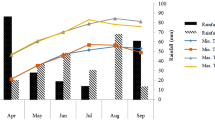Abstract
Soil, available water and nitrogen are limiting factors that restrict the production of wheat in arid lands of Iran. To evaluate the effects of nitrogen on yield and drought tolerance of rainfed wheat by stress susceptibility indices, a two-year field experiment was conducted under two irrigation conditions. Treatments consist of three nitrogen timing, as main plots including total nitrogen in fall, 2/3 in the fall+1/3 in the spring, and 1/2 in the fall+1/2 in the spring. The five nitrogen rates with 0, 30, 60, 90, and 120 kg.ha−1 of urea were applied as sub-plots. The experiments were conducted using randomized complete block designs in a split-plot arrangement with three replications during the 2012–2013 and 2013–2014 cropping seasons. The results showed that yield in stress and non-stress conditions were significantly and positively correlated with most of the drought stress indices (P < 0.01) and negatively correlated with the Stress Susceptibility Index, SSI, (P < 0.05). The Tolerance Index (STI) was the best index for drought tolerance. Results of nitrogen treatment showed that nitrogen increased drought tolerance, while applying 60 kg.ha−1 nitrogen in the fall was with the highest yield in wheat.
Similar content being viewed by others
References
Amini A, Hesami A. 2017. The role of land use change on the sustainability of groundwater resources in the eastern plains of Kurdistan, Iran. Environmental Monitoring and Assessment, 189 (6), 297, DOI: 10.1007/s10661-017-6014-3
Amini A, Gharibreza M, Shahmoradi B, Zareie S. 2018. Land aptitude for horticultural crops and water requirement determination under unsustainable water resources condition Environ Monit Assess. 191 (1), 11, DOI: 10.1007/s10661-018-7125-1
Antep S. 1997. Evaluation of some chemical of soil nitrogen available based on 15Nitrogen technique. Commun. Soil Sci. Plant Anal. 28: 537–550
Ayeneh A, Van Ginkel M, Reynolds MP, Ammar K. 2002. Comparison of leaf, spike, peduncle, and canopy temperature depression in wheat under heat stress. Field Crops Res. 79: 173–184
Barnabas B, Jager K, Feher A. 2008. The effect of drought and heat stress on reproductive processes in cereals. Plant Cell Environ. 31: 11–38
Brown PL. 1971. Water use and soil water depletion by dryland winter wheat as affected by nitrogen. Agron. J. 63: 43–46
El-Rawy MA, Hassan M. 2014. Effectiveness of drought tolerance indices to identify tolerant genotypes in bread wheat (Triticum aestivum L.). J. Crop Sci. Biotechnol. Vol. 17(4), pp 255–266
Feiziasl V, Fotovat A, Astaraei A, Lakzian A, Mousavi Shalmanim MA. 2014. Determination of soil and plant water balance and its critical stages for rainfed wheat using crop water stress index (CWSI). J. Water Soil. 28: 804–817 [in Persian]
Fernandez G. 1993. Effective selection criteria for assessing stress tolerance. In: CG Kuo, Ed.. Adaptation of food crops to temperature and water stress. Proceedings of an International Symposium of the Asian Vegetable Research and Development Center; 1992 Aug 13-18; Tainan
Fischer RA, Maurer. R. 1978. Drought resistance in spring wheat cultivars. Part 1: grain yield response. Aust. J. Agric. Res. 29: 897–912
Hafsi M, Akhter J, Monneveux P. 2007. Leaf senescence and carbon isotope discrimination in durum wheat (Triticum durum Desf.) under severe drought conditions. Cereal Res. Commun. 35: 71–80
Hesami A., Amini A. 2016. Changes in irrigated land and agricultural water use in the Lake Urmia Basin, Lake and Reservoir Management. 32(3): 288–296, DOI.org/10.1080/10402381.2016.1211202
Jepsen DR. 2010. Nitrogen management and variety selection for dryland production of hard red winter wheat in Northeastern Oregon, PhD. Dissertation, Corvallis University of Oregon State, US.
Johnston AM, Fowler DB. 1991. No-till winter wheat production: response to spring applied nitrogen fertilizer form and placement. Agron. J. 83: 722–728
Lopes MS, Araus JL. 2006. Nitrogen source and water regime effects on durum wheat photosynthesis and stable carbon and nitrogen isotope composition. Physiol. Plant 126: 435–445
Lopez-Bellidoa L, Rafael J Lopez-Bellidob, Ramon R. 2005. Nitrogen efficiency in wheat under rainfed Mediterranean conditions as affected by split nitrogen application, Field Crops Res. 94: 86–97
Malakouti MJ, Homaei M. 2004. Soil fertility in arid regions: Problems and solutions. Tarbiat Modares University Publication. Tehran, Iran
Meena NL, Seth J. 1974. Root distribution pattern and nitrogen uptake of some wheat and triticale germplasms in relation to rates and methods of nitrogen application. In: Symposium On use of radiation and radioisotopes in studies of plant productivity. Food and Agric. Committee of the Dept of Atomic energy, Govt. India
Naghavi MR, Pour-Aboughadareh A, Khalili M. 2013. Evaluation of Drought Tolerance Indices for Screening Some of Corn (Zea mays L.) Cultivars under environmental conditions. Not. Sci. Biol. 5(3): 388–393
Prihar SS, Sandhu KS, Singh M, Verma HN, Singh R. 1989. Response of dryland wheat to small supplemental irrigation and fertilize nitrogen in Submontane Punjab. Fert. Res. 21: 23–28
Rosille AA, Hambilin J. 1981. Theoretical aspects of selection for yield in stress and non-stress environments. Crop Sci. 21: 43–46
Ryan J, Pala M, Masri S, Singh M, Harris H. 2008. Rainfed wheat-based rotations under Mediterranean conditions: Crop sequences, nitrogen fertilization, and stubble grazing in relation to grain and straw quality. Eur. J. Agron. 28: 112–118
Sadat-Noori SM, Liaghat AM, Ebrahimi K. 2012. prediction of crop production using drought indices at different time scales and climatic factors to manage drought risk. J. Am. Water Res. Assoc. (JAWRA) 48(1): 1–9, DOI: 10.1111/j.1752-1688.2011.00586.x
Siose-Mardeh A, Ahmadi A, Postini K, Mohammadi V. 2006. Evaluation of drought resistance indices under various environmental conditions. Field Crop Res. 98, 222–229, https://doi.org/10.1016/j.fcr.2006.02.001
Van Herwaarden AF, Farquhar GD, Angus JF, Richards RA, Howe GN. 1998. Haying-off, the negative grain yield response of dryland wheat to nitrogen fertilizer. I. Biomass, grain yield, and water use. Aust. J. Agric. Res. 49: 1067–1081
Author information
Authors and Affiliations
Corresponding author
Rights and permissions
About this article
Cite this article
Sedri, M.H., Amini, A. & Golchin, A. Evaluation of Nitrogen Effects on Yield and Drought Tolerance of Rainfed Wheat using Drought Stress Indices. J. Crop Sci. Biotechnol. 22, 235–242 (2019). https://doi.org/10.1007/s12892-018-0037-0
Received:
Revised:
Accepted:
Published:
Issue Date:
DOI: https://doi.org/10.1007/s12892-018-0037-0




